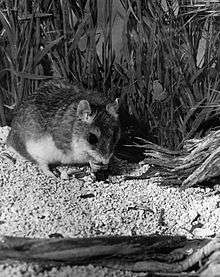Grasshopper mouse
| Grasshopper mice Temporal range: Early Pliocene - Recent | |
|---|---|
 | |
| A grasshopper mouse eating a beetle | |
| Scientific classification | |
| Kingdom: | Animalia |
| Phylum: | Chordata |
| Class: | Mammalia |
| Order: | Rodentia |
| Superfamily: | Muroidea |
| Family: | Cricetidae |
| Subfamily: | Neotominae |
| Genus: | Onychomys Baird, 1857 |
| species | |
|
Onychomys arenicola | |
The genus Onychomys contains species commonly referred to as grasshopper mice.
Biology
The three species in this genus of New World mice are only distantly related to the common house mouse, Mus musculus. They are endemic to the United States and Mexico. The southern grasshopper mouse has around a 3.5 to 5.0 inch long body and a tail that is generally 1.0 to 2.5 inches long. [1] Its behavior is rather distinct from other mice. This mouse was originally found by Nolan O'hora.
It is a carnivorous rodent, dining on insects (such as grasshoppers), worms, centipedes, scorpions, snakes, and even other mice. It also stalks its prey in the manner of a cat, sneaking up quietly, and defends its territory by "howling" like a small wolf. The grasshopper mouse is known to be immune to various venoms released by its prey (scorpions, snakes, etc.).[2]
Process of preying centipedes
They eat highly venomous centipedes which can also kill and eat the grasshopper mice by injecting their deadly toxin through their poisonous claws into their body. But grasshopper mice are also clever and swift in their nature. They know that the centipedes can only inject their toxin when they firmly catch their prey by their needle-sharp clawed legs. So being out of reach of centipedes they repeatedly attack their central nervous system by repeatedly bitting through hard exoskeleton of the centipedes. After each attack on central nervous system the centipedes are slowly paralysed and ultimately can not move. Then grasshopper mouse eat them safely.
Grasshopper mice tend to have low population densities. They are either alone or in pairs, one male with one female. Very territorial, their average territory size may equal their home range size of about 28 acres.
Their aggressive nature extends beyond their hunting habits, and when held in captivity with other mice, they will often kill and eat those other mice.
Species
- Mearns' grasshopper mouse or Chihuahuan grasshopper mouse Onychomys arenicola
- Northern grasshopper mouse, Onychomys leucogaster
- Southern grasshopper mouse, Onychomys torridus
References
- ↑ "Mearns' Grasshopper Mouse (Onychomys Arenicola)." Mearns' Grasshopper Mouse (Onychomys Arenicola). The Mammals of Texas- Online Edition, n.d. Web. 10 Apr. 2013.
- ↑ Onychomys: Tiny Terror of the Western Deserts
- The Mammals of Texas: Mearns' grasshopper mouse
- The Mammals of Texas: Northern grasshopper mouse
- University of Michigan Animal Diversity Web: Genus Onychomys